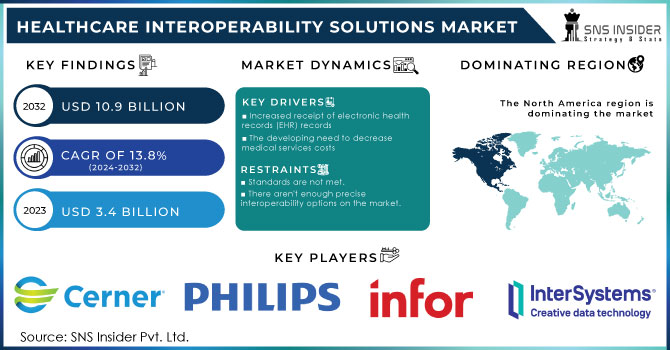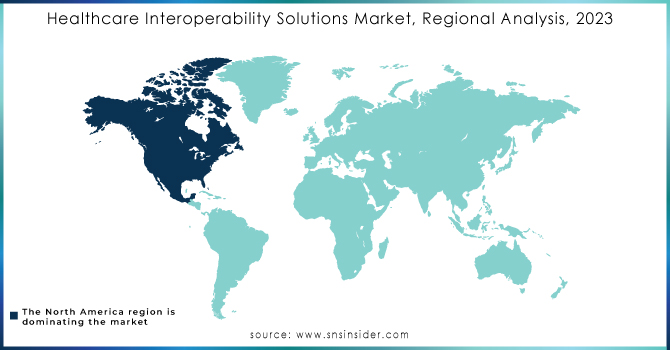Healthcare Interoperability Solutions Market Report Scope & Overview:

Get more information on Medical Tourism Market - Request Sample Report
The Healthcare Interoperability Solutions Market Size was valued at USD 3.4 billion in 2023, and is expected to reach USD 10.9 billion by 2032 and grow at a CAGR of 13.8% over the forecast period 2024-2032.
Healthcare Interoperability Solutions Market: Significant Growth Driven by Enhanced Infrastructure and Investment
The healthcare interoperability solutions market is experiencing robust growth, driven by increased adoption across healthcare systems and substantial investments aimed at enhancing healthcare infrastructure. Interoperability solutions facilitate the seamless exchange of information among various healthcare systems, enhancing patient outcomes and streamlining healthcare delivery. Key factors fueling this growth include favorable government initiatives, significant funding, and a growing emphasis on patient-centric care.
A pivotal example of government support occurred in February 2023 when the federal government allocated USD 505 million to federal data partners and Canada Health Infoway to advance digital health tools and develop an interoperability roadmap. This funding underscores the government's commitment to modernizing healthcare systems and improving patient care through advanced technology. Additionally, in May 2023, the Canadian government launched the "Connecting You to Modern Health Care" initiative, introducing an Interoperability Roadmap to ensure access to electronic health information. These programs are expected to accelerate market growth by promoting interoperability solutions across healthcare facilities.
Healthcare providers are increasingly seeking interoperability solutions to enhance care delivery and reduce costs through timely access to patient data. Effective information sharing across systems is crucial for improving clinical decision-making, reducing diagnostic delays, and delivering personalized care. Patients benefit from better care coordination, leading to improved health outcomes.
Mergers and acquisitions are shaping the market as companies consolidate their positions and expand their capabilities. For example, in September 2023, Enovacom, a leader in healthcare data interoperability solutions, acquired Xperis and NEHS Digital, enhancing their data interoperability offerings. This trend is expected to continue as market players seek to offer comprehensive solutions and gain a competitive edge.
Interoperability solutions offer numerous benefits, including informed decision-making, efficient care delivery, compliance with privacy regulations, and swift access to critical health information. According to RevenueXL Inc. (March 2023), these solutions improve care quality and reduce costs by facilitating seamless data exchange across organizations. However, challenges such as integrating disparate systems, unreliable data infrastructure, and data privacy concerns persist. Regulatory authorities, such as the Centers for Medicare & Medicaid Services (CMS), are addressing these issues with rules like CMS-0057-P and CMS-9115-F, which emphasize health information exchange and privacy protections.
The healthcare interoperability solutions market is set for substantial growth as governments, healthcare providers, and industry players collaborate to enhance data exchange capabilities. While challenges remain, ongoing investments, government support, and a focus on better patient outcomes are expected to drive market expansion. Mergers and acquisitions will continue to influence the competitive landscape, with companies aiming to enhance their market presence and capabilities. As demand for high-quality healthcare increases, interoperability solutions will play a crucial role in transforming global healthcare delivery.
MARKET DYNAMICS
Drivers
-
Driving Healthcare Innovation with Interoperability and Data Integration
Interoperability enhances data exchange efficiency, minimizes duplicate procedures, and improves patient safety. By enabling smoother communication among healthcare systems, interoperability ensures that critical patient information is accessible across various settings, reducing redundant tests and interventions and improving overall care quality. For instance, hospitals can save up to USD 71,000 annually by eliminating duplicate tests, as reported by the American Hospital Association. Additionally, the National Coordinator for Health Information Technology (ONC) notes that interoperability prevents approximately 2.7 million adverse drug events annually, further promoting patient safety. Government support is crucial in expanding interoperability standards, fostering collaboration among providers, and enhancing patient care. Legislation like the 21st Century Cures Act mandates open APIs for data exchange, and the ONC's Final Rule on Information Blocking ensures the elimination of data-sharing barriers. These measures encourage the adoption of interoperable systems that improve care delivery and safety.
Technological advancements in healthcare also drive growth in interoperability solutions by reducing manual tasks, minimizing redundant procedures, and lowering costs. Interoperability mitigates the financial impact of new technologies by improving operational efficiency and clinical care through access to relevant patient data. Increased connectivity between healthcare facilities enhances collaboration and data exchange, facilitating interdisciplinary decision-making and improving patient outcomes. Interoperable platforms, such as telemedicine systems, enable seamless consultations between healthcare teams and specialists, ensuring timely interventions and enhanced care delivery.
Restraints
-
Inconsistent Standards and Limited Solutions Hinder Data Exchange
Inconsistent standards and diverse vendors pose significant challenges to seamless data exchange in the healthcare interoperability solutions market. Compatibility issues arise from varied standards and numerous vendors, obstructing smooth data sharing between systems. According to a survey by the American Health Information Management Association (AHIMA), 59% of healthcare organizations view inconsistent standards as a major barrier. These inconsistencies include differences in data formats, coding schemes, and terminology, complicating effective communication among systems. A study in the Journal of the American Medical Informatics Association estimates that large hospitals could spend up to USD 1 million annually on interoperability-related activities. Additionally, difficulties in meeting interoperability standards lead to data silos and reduced functionality, while a lack of diverse, reliable solutions and a shortage of skilled IT professionals further impede market growth and efficiency.
Key Segmentation
By Type
Software solutions dominated the market, holding approximately 65% of the total revenue share in 2023. These solutions are essential for enabling data exchange, translation, and integration across various healthcare systems. Key software offerings include API Management Platforms (e.g., InterSystems HealthShare, Google Cloud's Apigee), Data Integration Engines (e.g., Informatica PowerCenter, IBM Cloud Pak for Integration), and Master Patient Index (MPI) Solutions (e.g., NextGen Masterpiece MPI, Cerner Millennium MPI). The services segment, accounting for an estimated 35% of the market share, supports the implementation and management of interoperability solutions. This segment is growing due to increased demand for expert support, including Consulting Services (e.g., Accenture, Deloitte), Implementation Services (e.g., IBM, Hewlett Packard Enterprise), Integration Services (e.g., Optum, Cognizant), and Managed Services (e.g., Amazon Web Services, Microsoft Azure).
By Level
Foundational Interoperability holds the largest share at 40%, as it establishes the groundwork for data exchange by ensuring connectivity using standardized protocols like HL7 and DICOM. It facilitates basic data transfer but does not ensure meaningful interpretation. Structural Interoperability, with a 30% market share, advances beyond basic connectivity by ensuring data consistency through standardized vocabularies and codes like LOINC and SNOMED CT. This enhances data analysis and comparison. Semantic Interoperability, also representing 30% of the market, ensures that the meaning of the data is understood across systems, leveraging ontologies and clinical decision support tools to provide a comprehensive view of patient information.
By End User
Healthcare providers i.e. Hospitals and clinics dominate the market, commanding a substantial 55% share. These institutions need robust data exchange capabilities to manage complex patient cases involving multiple specialists. The demand for interoperability solutions is driven by the need for seamless integration with Electronic Health Records (EHRs), real-time communication among healthcare teams, and secure data exchange with referring physicians. Advancements in telehealth and remote patient monitoring are expected to boost adoption further. Companies can capitalize on this by addressing specific needs across various hospital sizes and specialties, enhancing usability and security, leveraging cloud-based solutions, and forming strategic partnerships with EHR vendors and IT companies.
Regional Analysis
In 2023, North America led the healthcare interoperability solutions market with a revenue share of 43%. The growing demand for efficient healthcare services, cost reduction, and successful EHR implementation are key drivers. The U.S. market is projected to grow rapidly, supported by initiatives like the August 2023 funding of USD 2 million by the Office of the National Coordinator for Health IT (ONC) to Boston Children’s Hospital and HEALTHeLINK for improving FHIR data quality. Europe is emerging as a lucrative market, with the UK expanding rapidly due to NHS England support and France focusing on digital platforms to cut healthcare costs. Asia Pacific is expected to witness the fastest growth, driven by increasing demand for quality healthcare and heightened government spending. China, with its large patient population, and Japan, with major players like FUJITSU launching digital platforms, are leading regional expansion, highlighting the growing importance of interoperability across global healthcare markets.

Need any customization research on Medical Tourism Market - Enquiry Now
Key Players
Notable players in the market include:
-
Jitterbit
-
NXGN Management, LLC.
-
Cerner (Oracle)
-
Epic Systems Corporation
-
Veradigm Inc.
-
OSP Labs
-
Infor (Koch Industries, Inc.)
-
iNTERFACEWARE Inc.
-
Koninklijke Philips NV
-
InterSystems Corporation
-
ViSolve.com
-
Orion Health Group
-
Allscripts Healthcare Solutions
-
Quality Systems, Inc., and others.
Recent Developments
-
Philips Healthcare (August 2024) launched updates to their Interoperability Solutions, streamlining patient data sharing across networks. The enhancements support radiation therapy referrals, and cross-enter.
-
Carequality (July 2024) announced that they are now facilitating the exchange of over 1 billion healthcare documents per month through their interoperability framework. This platform enables secure, nationwide data sharing between healthcare networks, helping to reduce the cost of individual data-sharing agreements. Several key healthcare providers, including NextGen and eClinicalWorks, have adopted Carequality to improve care coordination and patient data accessibility.
| Report Attributes | Details |
|---|---|
| Market Size in 2023 | US$ 3.4 Billion |
| Market Size by 2032 | US$ 10.9 Billion |
| CAGR | CAGR of 13.8% From 2023 to 2032 |
| Base Year | 2023 |
| Forecast Period | 2024-2032 |
| Historical Data | 2020-2022 |
| Report Scope & Coverage | Market Size, Segments Analysis, Competitive Landscape, Regional Analysis, DROC & SWOT Analysis, Forecast Outlook |
| Key Segments | • By Type [Software Solutions, (EHR interoperability solutions, Lab system interoperability solutions, Imaging system interoperability solutions, Healthcare information exchange interoperability solutions, Enterprise interoperability solutions), Services] • By Level [Foundational Interoperability, Structural Interoperability, Semantic Interoperability] • By End User [Healthcare Providers, Healthcare Payers, Pharmacies] |
| Regional Analysis/Coverage | North America (US, Canada, Mexico), Europe (Eastern Europe [Poland, Romania, Hungary, Turkey, Rest of Eastern Europe] Western Europe] Germany, France, UK, Italy, Spain, Netherlands, Switzerland, Austria, Rest of Western Europe]), Asia Pacific (China, India, Japan, South Korea, Vietnam, Singapore, Australia, Rest of Asia Pacific), Middle East & Africa (Middle East [UAE, Egypt, Saudi Arabia, Qatar, Rest of Middle East], Africa [Nigeria, South Africa, Rest of Africa], Latin America (Brazil, Argentina, Colombia, Rest of Latin America) |
| Company Profiles | Jitterbit, NXGN Management, LLC., Cerner (Oracle), Epic Systems Corporation, Veradigm Inc., OSP Labs, Infor (Koch Industries, Inc.), iNTERFACEWARE Inc., Koninklijke Philips NV, InterSystems Corporation, ViSolve.com, Orion Health Group, Allscripts Healthcare Solutions, Quality Systems, Inc., and others. |
| DRIVERS | • Driving Healthcare Innovation with Interoperability and Data Integration |
| RESTRAINTS | • Inconsistent Standards and Limited Solutions Hinder Data Exchange |

